As an online Spanish tutor I would like you to remember the name of these ingredients when you finish reading this article, because as you will discover, they have been a staple in Spanish gastronomy for over 400 years. Furthermore, they are such a fundamental part of our diet that even Miguel de Cervantes himself included them in the most renowned Spanish novel in history: The Ingenious Gentleman Don Quixote of La Mancha.
Well, these ingredients are: ham (jamón), chorizo, cod (bacalao), onion (cebolla), pepper (pimiento), garlic (ajo) and tomato (tomate). But before diving into the gastronomy of Don Quixote, as an online Spanish tutor I would like to establish the context of both the novel, the author and the time period in which we are discussing.
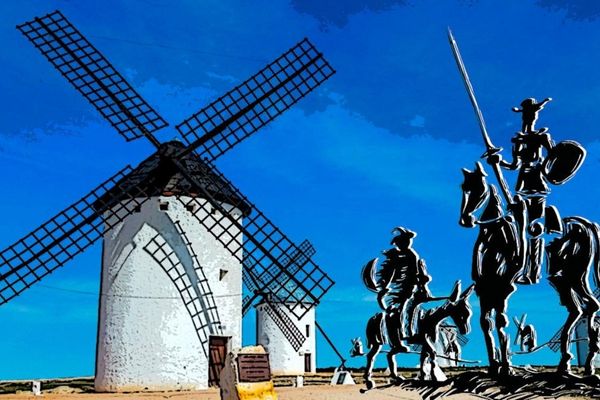
Don Quixote and Sancho Panza are the protagonists of this novel, written by Miguel de Cervantes Saavedra and published under the title The Ingenious Gentleman Don Quixote of La Mancha at the beginning of 1605. In 1615 the continuation of the adventures of Don Quixote and Sancho was published, in which it became the most outstanding work of Spanish literature.
This work represents the first modern novel to demystify the chivalric and courtly tradition of books written earlier during the Middle Ages. It is also the first polyphonic novel in which, through the characters, a diversity of perspectives and voices on reality is shown. It has been said of this novel that it is ‘the best literary work ever written.’
The novel tells the adventures of Alonso Quijano, Don Quixote, a poor hidalgo, of the low nobility, who has lost his mind reading many books of chivalry. That is to say, Don Quixote believes himself to be a mediaeval knight-errant. He is moved by the great values of goodness, courage and defence of the weak, in a reality in which his crazy mind confuses mills with giants, prostitutes with great ladies of the court and flocks of sheep with armies of soldiers.
In his adventures, he is accompanied by his faithful squire, Sancho Panza, and his horse, Rocinante. In his thoughts, his beloved lady, Dulcinea del Toboso, is always present.
No less interesting than his character is the author of the work, Miguel de Cervantes. He was born in Alcalá de Henares, in 1547. At the age of 19 or 20, he went to Madrid, where he studied. In 1569 he arrived in Rome, to work in the service of Cardinal Giulio Acquaviva and soon after, he enlisted in the army as a soldier under the command of Captain Diego de Urbina. This led him to fight in the Battle of Lepanto, a naval battle that took place in October 1571, near the Greek city of Naupactus. This is where his famous nickname of the one-armed from Lepanto (el manco de Lepanto) comes from, since he suffered damage to his left arm.
He spent a few more years in Italy, and on his return to Spain, the ship he was travelling on was captured. The prisoners were taken to Algiers. There, Cervantes was held captive for five years (he tried to escape up to five times!). Finally, his ransom was paid by his family and Cervantes was able to return to Spain in 1580.
Once back in Spain, he worked in the king’s service as a tax collector and began writing novels and plays as a playwright.
In my classes, as an online Spanish teacher, I always like to provide an introduction before delving into a specific topic.
In the case of the adventures of Don Quixote, it’s important to understand the time and place in which Cervantes’ novel is set. The story is set in the late 16th Century, known as the Golden Age of Spain.
Philosophy, art and literature flourished during the Spanish Golden Age (the famous painting by Diego Velázquez, Las Meninas, 1656, also dates from this period). This time coincided with the political and military rise of the Spanish Empire of the House of Trastámara and the House of Austria. Generally, it is considered that it began in 1492 with the end of the Christian Reconquest and the Discovery of America and ended in 1659, the year in which Spain and France signed the Treaty of the Pyrenees.
As for the area of Spain in which the Don Quixote plot takes place, it is in La Mancha, a region located in the centre of Spain, which occupies part of the current provinces of Albacete, Ciudad Real, Cuenca and Toledo. It is an area of large plains, with cold winters and very hot summers, where game (rabbit, hare and partridge), flocks of sheep and crops such as garlic, vineyards and cereal fields are abundant.
Specifically, some of the towns mentioned in Cervantes’ novel and where you can see the famous windmills are:
Gastronomy is very present throughout the novel, starting from chapter 1. And although the dishes that you are going to discover in this article are centuries old, we still cook and eat them today, especially in the region of Castilla La Mancha, in the interior of Spain.
As an online Spanish tutor, in my classes I love to always include something related to the culture of Spain or Latin America. I think that this is something that my students really appreciate and that also motivates them to continue learning Spanish… So, here is a round of traditional gastronomy!
1. Olla podrida (Rotten pot)
The ingredients used in this dish are pig’s ear and leg, bacon, chorizo, ham, black pudding, black beans, some vegetables, breadcrumbs, garlic and salt.
It is called ‘rotten’ because it cooks very slowly, sometimes so slowly that it seems that the ingredients are going to rot… but nothing is further from the truth. It is a dish that is eaten hot, ideal for winter.
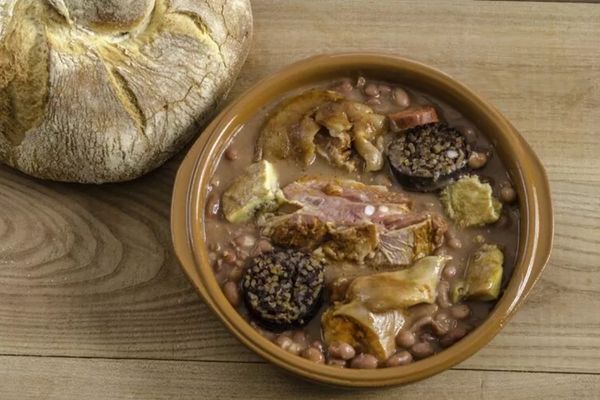
2. Salpicón manchego
This dish should not be confused with the popular ‘seafood salad’ which is also called salpicón. The Manchego salpicón is made with the remains of the rotten pot and is eaten cold, without broth. The ingredients are the remains of the meat from the rotten pot, serrano ham, onion, oil, vinegar and salt.
3. Duelos y quebrantos (Mournings and breakings)
They are scrambled eggs with bacon, chorizo, ham and lamb brains (although this last ingredient can be removed depending on the taste preference of the consumer).
Some scholars maintain that the name of this dish alludes to the ‘breaking’ of the fast imposed on pork in the Jewish and Islamic religions and the subsequent ‘mourning’ after breaking the fast.
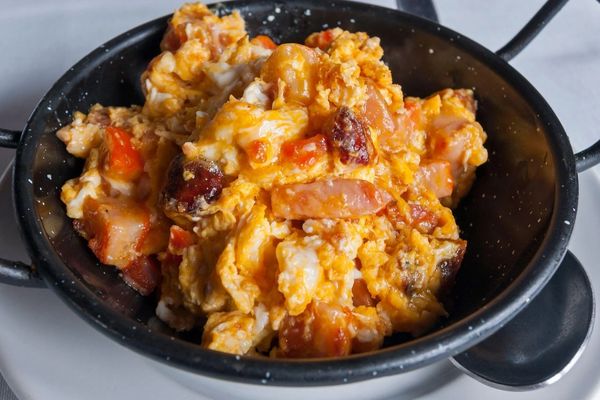
4. Gazpacho de pastor (Shepherd’s gazpacho)
This dish should not be confused with the cold gazpacho that is eaten in summer with tomato, pepper, cucumber, onion and garlic. Shepherd’s gazpacho or Manchego gazpacho is a typical dish of the shepherds of La Mancha who lived in rural areas. It is made with partridge, hare, rabbit, chicken, oil, paprika, bread and salt. It is eaten hot and has a little broth.
5. Tojunto (Todo junto = Everything together)
Its ingredients are beef, potatoes, peppers, garlic, saffron and salt. The meat is fried a little in a pan and then it is cooked all together slowly in a pot. As the Manchego proverb says: ‘the tojunto is written together and cooked separately.’
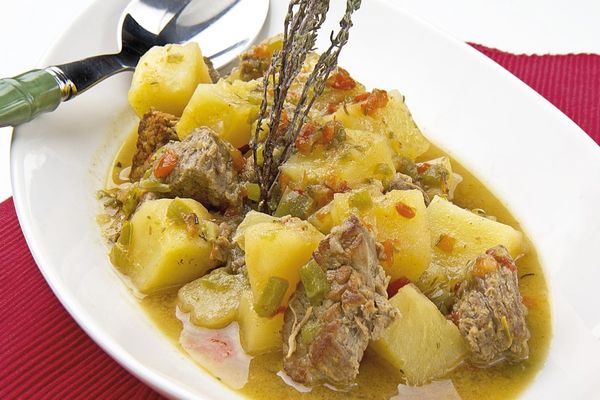
6. Atascaburras
It is eaten cold or warm and its main ingredient is cod. Boiled potatoes, garlic and parsley are added to the cod and a paste is made which is garnished with boiled egg and paprika.
7. Tiznao
The main ingredient of tiznao is also cod. It is a delicious dish in which the ingredients are cod, potatoes, red peppers, garlic, onions, sweet paprika, oil and salt.
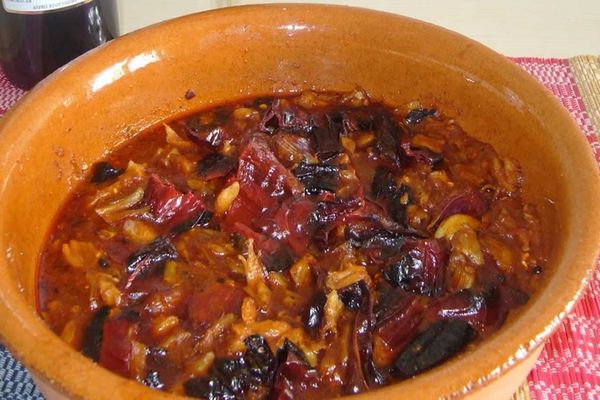
8. Morteruelo
This is a dish of mediaeval origin, of which the recipe and ingredients have remained intact from generation to generation. It is eaten hot and spread on bread, since the texture is a kind of consistent paste.
The ingredients are pork liver, partridge, chicken, Serrano ham, pork bacon, breadcrumbs, black pepper, bay leaf, thyme, paprika, cloves, cinnamon, oil and salt.
It is made by mixing the ingredients slowly and for hours in a mortar (mortero), hence its name, morteruelo.
9. Pestiños y frutas de sartén (Pestiños and pan fruits)
We finish the review of the dishes of Don Quixote’s gastronomy with dessert. Pan fruits are made from flour, eggs and sugar. They take different shapes and are fried in the pan with olive oil. They are accompanied with sugar or honey. Examples of these sweets are fried flowers, hojuelas, rolletes…
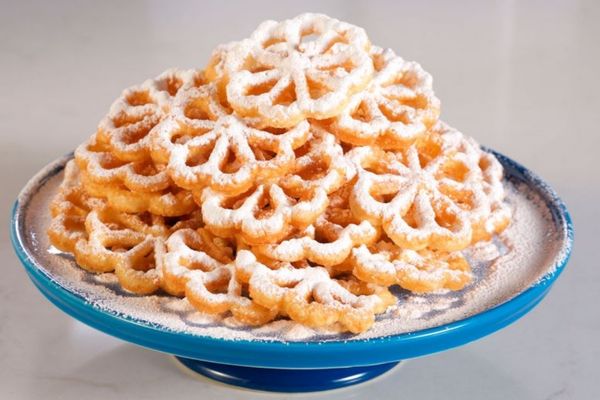
If you have enjoyed reading this article, you can continue to do so with our Spanish classes for adults and our online Spanish tutors.
Take a look at our catalogue of online Spanish classes, our Membership Programme and book your trial class today with one of our accredited native teachers.
You can continue to savour the impressive gastronomic heritage that Spain and Latin America have through language and also literally, through the dishes that we have seen in this article.
Go ahead and press play on some of the videos included in the recipes and enjoy as Don Quixote did in his day.
¡Buen provecho!
